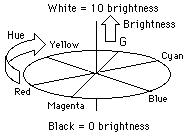Hue
Hue, along with saturation and brightness make up the three distinct attributes of color. The terms "red" and "blue" are primarily describing hue - hue is related to wavelength for spectral colors. It is convenient to arrange the saturated hues around a Newton Color Circle. Starting from red and proceeding clockwise around the circle below to blue proceeds from long to shorter wavelengths. However it shows that not all hues can be represented by spectral colors since there is no single wavelength of light which has the magenta hue - it may be produced by an equal mixture of red and blue.

|
There are many different mixtures of wavelengths which can produce the same perceived hue. The achromatic line from black to gray to white through the center of the circle represents light which has no hue. |
Vision concepts
Color vision
| HyperPhysics***** Light and Vision | R Nave |


